The diving watch category is perhaps the most exciting of all categories in the watch industry.
Maybe because it was started by two great brands, Blancpain (with Aqualung FF) and Rolex (submariner) in 1954. The Submariner by Rolex, especially, captured the imagination of diving watches like no other brand. The case and design, pure, simple and clean.
However there is another great brand that made some killer diving watches: Jaeger-LeCoultre.
From the incredibly beautiful Deep Sea Alarm – the US version is my preferred with the playful script– to the Polaris 1965 and 1968 – Jaeger-LeCoultre (or simply Le Coultre depending where the watch was sent to) made some of the most beautiful diving watches of all.
We are going to look at one model in particular: The E859 or 1968 Polaris.
(Main Picture Credit: JF).
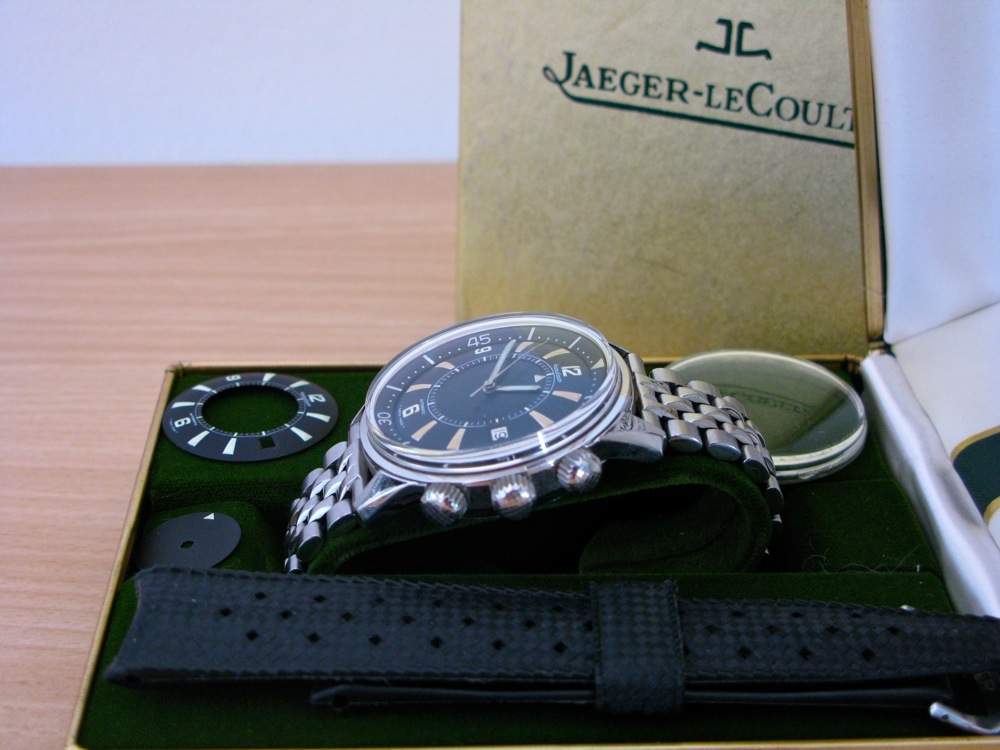
For many, the Polaris with its oversized case and overlarge Hesalite crystal (that makes the dial look like an aquarium), is one of the beautiful diving watches ever made. Rather than write an in-depth report like with other brands, this time the format is going to slightly change.
I am going to look at the Polaris in detail by interviewing a collector who knows a heck of a lot more about the Polaris than I do. I think this format is a different and perhaps easier way to read an in-depth report about a watch.
M, also known as Mstanga, is a scholar and collector of watches based in Italy. He owns a superb example of the Polaris and also wrote a comprehensive guide to collecting this watch. There is simply no better person to ask about the Polaris.
Tell me about the Polaris. When was it introduced?
Mstanga: The initial start came in 1959 when Jaeger-LeCoultre first thought about creating a diving watch with alarm. Mr. Lowe, who was president of the LeCoultre Watch in New York, submitted a letter to the Jaeger-LeCoultre Board of directors proposing to create a diving watch with an alarm function. The result was the Memovox Deep Sea Alarm ref E857 from 1959 equipped with the calibre K815. A little more of 1000 pieces were made of this reference and it was the first automatic diving alarm wristwatch in the world.
However the Polaris as we know it today was born in July 1963 when 50 prototypes were created of ref E859 called ‘Memovox de plongee’ (see picture below). It was a large case of 42mm which was exceptionally large for that time, but perfect for underwater legibility.
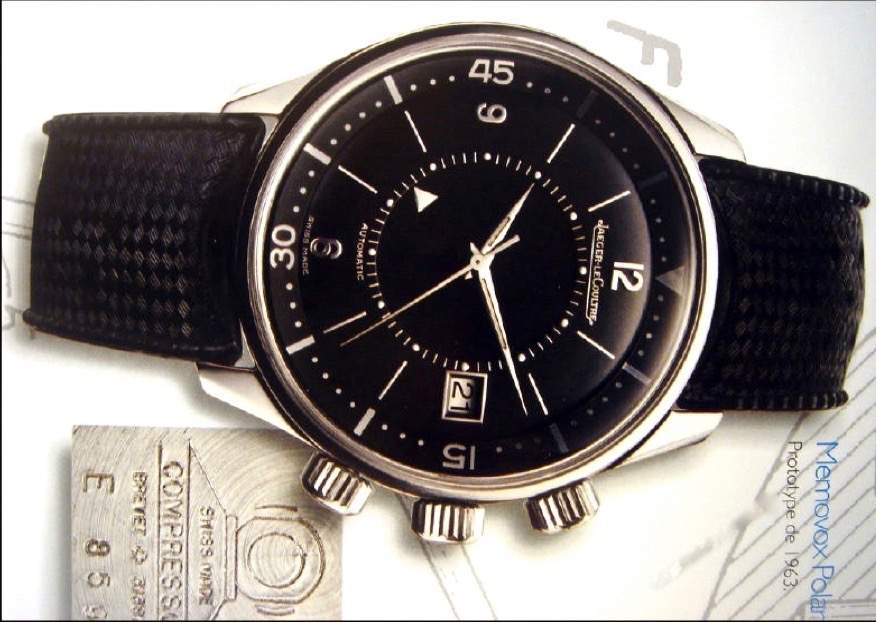
The name Polaris came about as the US division of Jaeger-LeCoultre wanted a name to describe the growing spirit of adventure, be it water or polar expeditions or space.
How many Polaris were made and how long was the watch in production?
Mstanga: The Polaris ref. E859 was made in 1714 pieces between 1965 and 1970 in all its variants* (1965, 1966, 1967, 1968 and 1968 Calypso version). It was delivered with a plastic strap “tropic” 22mm or on demand with a steel bracelet produced by “JB Champion USA “(very difficult to find these days – see picture below).
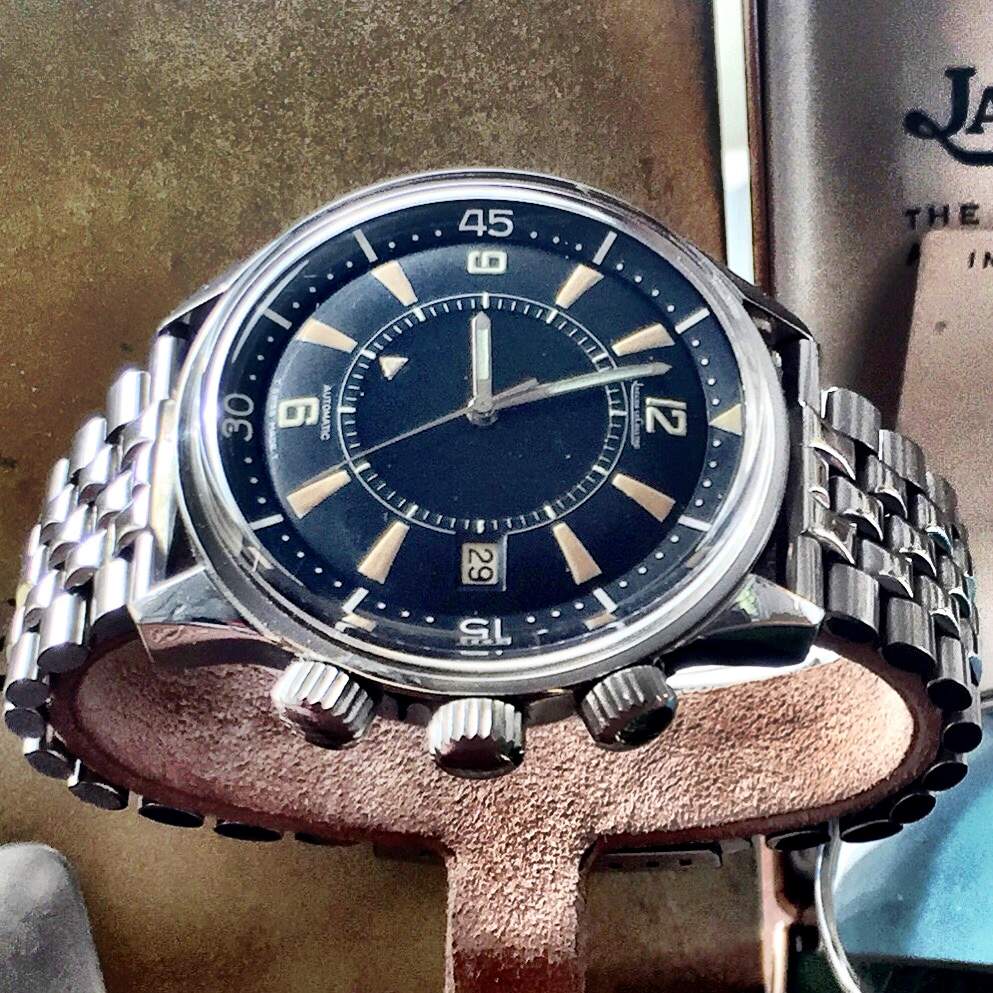
Although the number of pieces made might seem modest by today’s standard. it was considered a huge success at the time. With time the watch has become an Icon of design and functionality. Today, the Polaris E859 – especially the 1968 version is one of the most collectible wristwatches in the market.
The production numbers are also confirmed by the Extract of archives below.
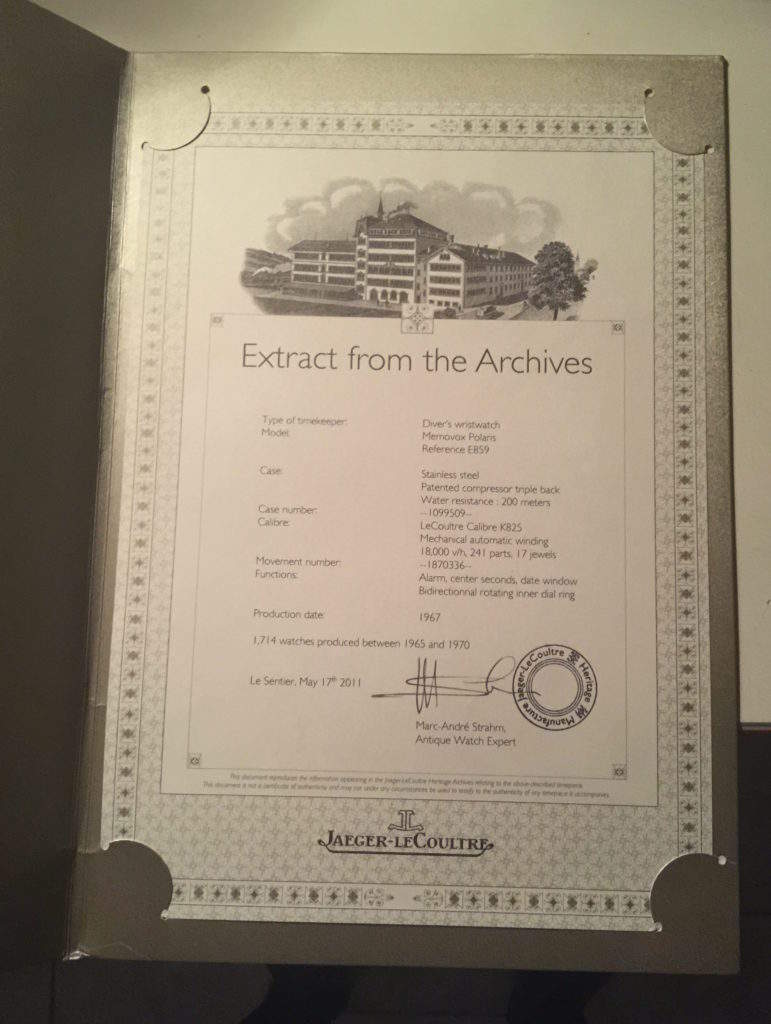
The breakdown of the total 1714 is as follows:
- Prototype in 1963: 50 units (never commercialized and not counted in 1714)
- 1965 version: 500 units
- 1968 version: 1214 units of which 1150 units produced in 1968, 9 units produced in 1967 (with the year 67 highlighted on the inside of the caseback)
- 55 units produced in 1970 (controversial calypso hands version)
All model variants have the same stainless steel case model, blacks dials, date at 3 o’clock and the K825 caliber, but have different indexes, hands and casebacks.
Can you explain the technical aspects of the watch?
Mstanga: The Polaris is a technical masterpiece!
A unique system was developed to allow the alarm sound to be more audible under water and it was cased in a triple caseback that enabled it to be water resistant to 200 meters. It was also equipped with the patented ‘Piquerez Compressor System’. To ensure better operating security, the rotating ring was positioned under the glass activated by a third crown.
The case back also carried the compressor logo to indicate the high level of water resistance – btw this logo was also used by Jaeger later on in their wristwatch line ‘Master Compressor’.
Here is an interesting fact!
Unlike some LeCoultre watches which were produced in Switzerland but had the final assembly carried out in the US, all the Jaeger-LeCoultre Polaris watches were made entirely in Switzerland to ensure perfect impermeability (water resistance) standards. Made in Switzerland – clearly stands for quality!
A few words should also be mentioned concerning the alarm system which is a marvel and superb innovation.
A unique system was developed by engineers of JLC to allow the alarm sound to be more audible under water. A triple caseback was created in order to prevent the sound being diluted or muffled from contact with the same movement. The outer caseback was made in completely smooth steel with 16 circular holes adapted to allow the alarm sound to amplify outside.
So even under water – the alarm is perfectly audible. Incredible!
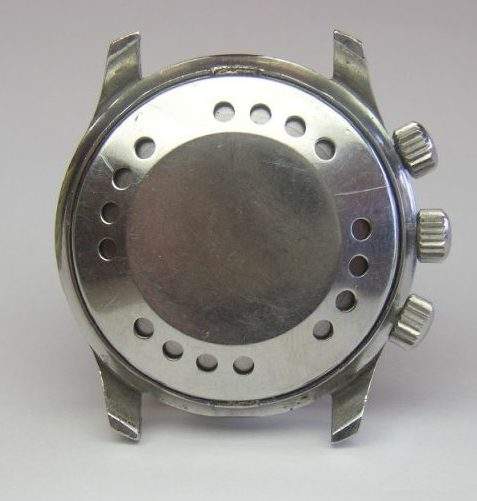
Why are collectors are attracted to the Polaris?
Mstanga: Today the Polaris is a cult watch!
Its size, design and rarity, particularly with respect to the model 65 and model 68, are becoming increasingly appreciated by collectors. Some collectors are convinced (myself included) that if the Polaris never existed and only today suddenly appeared on the market, it would be recognized and accepted as a modern timepiece! I am sure it would be a big hit today – especially in a market today that is eager for new ideas and interesting products.
What do you like about the Polaris?
Mstanga: Well, it is easy to answer this question: I like everything, starting from the J. B. Champion bracelet which was sold as an option for the American market, to the characteristic triple caseback with those sixteen holes, to the three crowns, to the incredibly beautiful dial with rotating inner bezel up to the huge Hesalite crystal. All this together forms a rare beauty, probably the most beautiful diver watch ever made!
Are both dials Jaeger Le Coultre and LeCoultre correct for the Polaris E859?
Mstanga: Inside the 1968 version there are two sub-versions, one of them is marked “LeCoultre” and the other “Jaeger-LeCoultre”, depending on whether the place of marketing were the USA or Switzerland. We can find at six o’clock the “T SWISS T” or “T SWISS MADE T”. Both are correct for the Polaris E859.
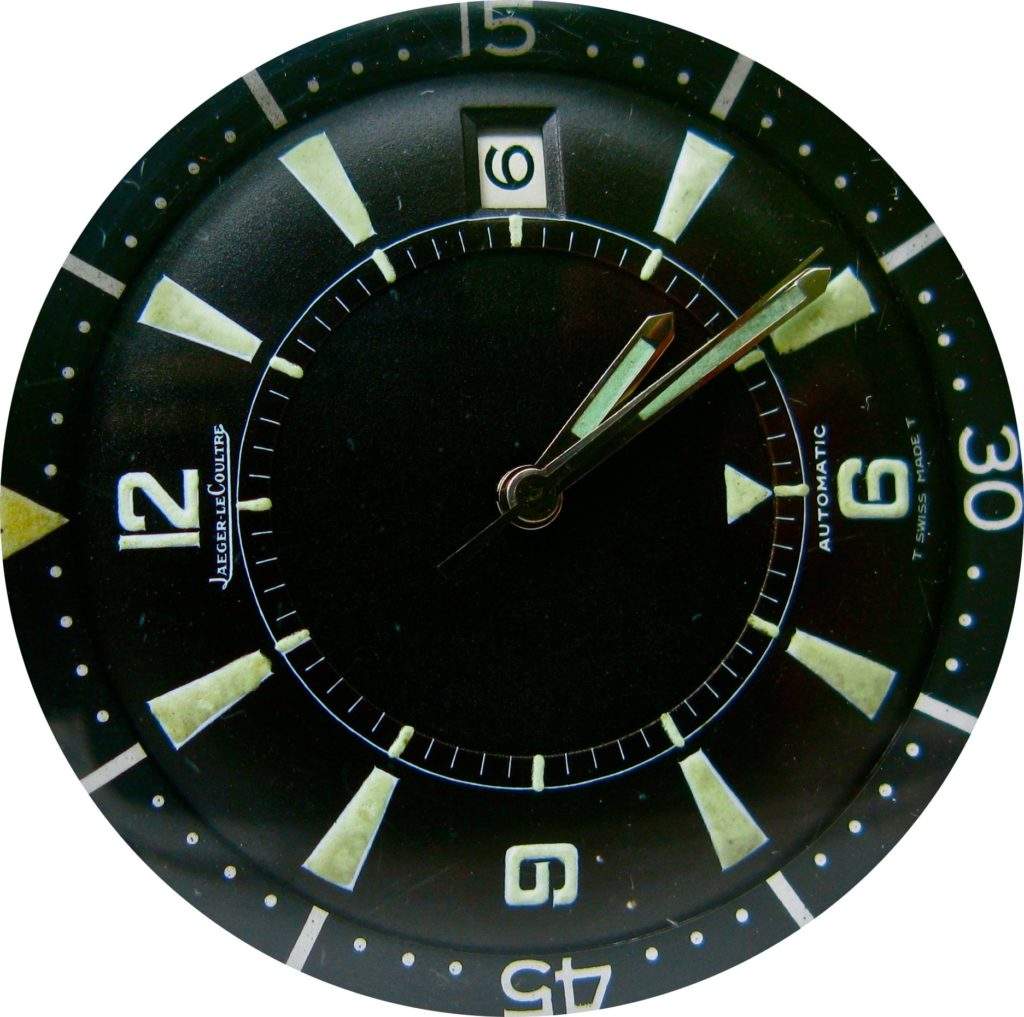
Which dial is more attractive to you: Jaeger-LeCoultre or LeCoultre?
Mstanga: Both but maybe the Jaeger-LeCoultre dial is more attractive to me.
What should collectors pay attention to when buying a Polaris?
Mstanga: If the dial is marked LeCoultre then it is preferable that the movement ‘bridge’ is also marked LeCoultre and so is the box, consequently if the dial is marked instead Jaeger-LeCoultre then it is preferable that the movement ‘bridge’ is marked Jaeger- LeCoultre. Please note that this rule, however, must be taken into account with a bit of ‘elasticity‘ and in case of discrepancy still has to be checked: For example does the movement serial number correspond with the year of production of the watch itself. An exception to the above rule is the internal caseback that in all cases (both version 65 and 68) must be marked LeCoultre! See picture below.

Regarding the inner caseback: The inner caseback of the 1965 version should have the year 65 preceded by a hyphen and the number of the month (for example 5-65), so the 1968 version should have the year 68 preceded by a hyphen and the number of the month (for example. 5- 68).
If the dial is LeCoultre then the alarm disc must have the “Memovox” indication, or in some rare case “Memodate”, vice versa if the dial Jaeger-LeCoultre, the alarm disc should ideally have not anything written.
Since the K825 caliber was also used into a huge number of other non- divers JLC the same serial number must fall within certain ranges, same thing can be said of the Case serial number (found engraved on the inside back). For example for the 1968 Polaris E859 the movement serial number should be between 1.925.000 and 2.100.000 and the case serial numbers should be between 1.115.000 and 1.160.000 (I would like to point out that the serial numbers are from data collected over the years and cannot be interpreted strictly).
Is it correct to assume that the lume is not all the same color on the outer triangle (that rotates), the indexes on the dial and on the alarm disc?
Mstanga: The dial is composed of a central swivel (inner) disk for pointing to the time that the owner would like the alarm to sound. In addition there is the quadrant with large tritium indices and numerical indication of the hours 6-9 and 12. Last there is the inner ring for the calculation of immersion time. This all together contributes to give the watch a beautiful and perfect symmetry.
I would like to point out the following regarding the dial: The color of the indexes can be of several color variations, from pale light green, green, green yellow, light orange to yellow even to orange. Yes, I have seen all these colors!
Therefore I believe that several variations of index colors are correct. However it is different in regards to the color of the hands. The color of the hours and minutes hands must be dark green in color so as to create a “non color matching” effect. See picture below for what I mean by different colour!
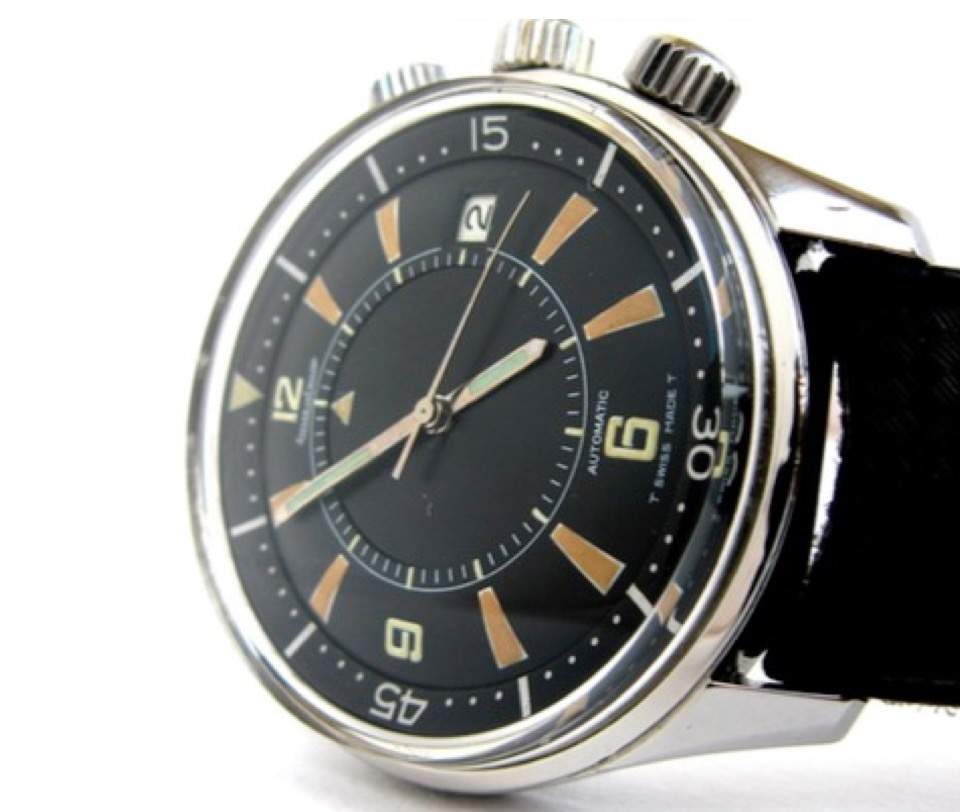
Tell me more about the three winding crowns of the Polaris. How should correct ones look like?
Mstanga: The three beautiful crowns have a particular decoration called ‘quadrille’.
The first at 2 o’clock is used to charge the alarm spring and if extracted has the dual function of setting up and stopping of the alarm signal itself, the second at 3 o’clock is used to rotate the inner ring (to set the alarm), and the third at 4 o’clock is used for charging the watch and, if extracted or pulled out, to adjust the time and date. See original crowns below.
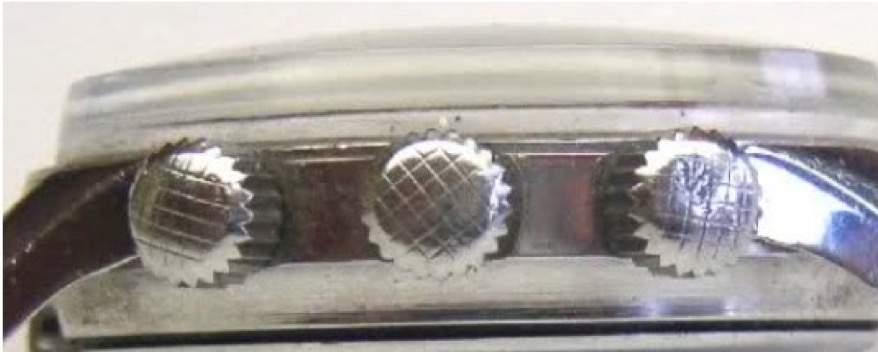
The after service crowns are easy to recognize because unlike the original ones, they have a circle around the decoration of the crown itself. See service crown below.

Do you see much demand for the Polaris in the current collectors market?
Mstanga: I do not know a single collector who does not like the Polaris, and although the market is increasingly dominated by the usual brands and the usual models, the Polaris has a special place among connoisseurs of sophisticated diving watches.
Do you come across many fakes?
Mstanga: Actually not that many as you would expect. However from time to time I come across them. See picture here for a fake Polaris.
You wrote guides on some of the greatest watches ever made. Nautilus, Royal Oak, Speedmaster & the Amagnetic from Patek. Is the Polaris one of the all time great watches?
Mstanga: For me the Polaris is ALREADY a great watch to own. It is so different from what we are used to seeing and to wearing everyday.
Let us now take a look at some pictures of this superb diving watch – the Polaris E859. Only once you try one on, do you feel the magic of the Polaris. Credit all pictures above except archive: Mstanga. In full disclosure I own a 1968 Polaris Jaeger-LeCoultre in my private collection.
Many collectors including myself are attracted to the Polaris because of the large plexi made out of Hesalite. Not to mention the large size of the case.

Here another great shot of the Polaris Hesalite and dial size. The Polaris E859 is a very large watch at 42mm.

Even though the watch is large – it sits perfectly on the wrist – even if your wrist is not large. Look how it fits me (I have a rather small wrist).
I love the 3 winding crowns – they are a piece of art in itself! (To remind readers: Top crown is for winding up the alarm, middle crown for rotating the inner ring to set the alarm and the last crown at 4 o’clock for not only winding the watch but also setting the time – when pulled out).
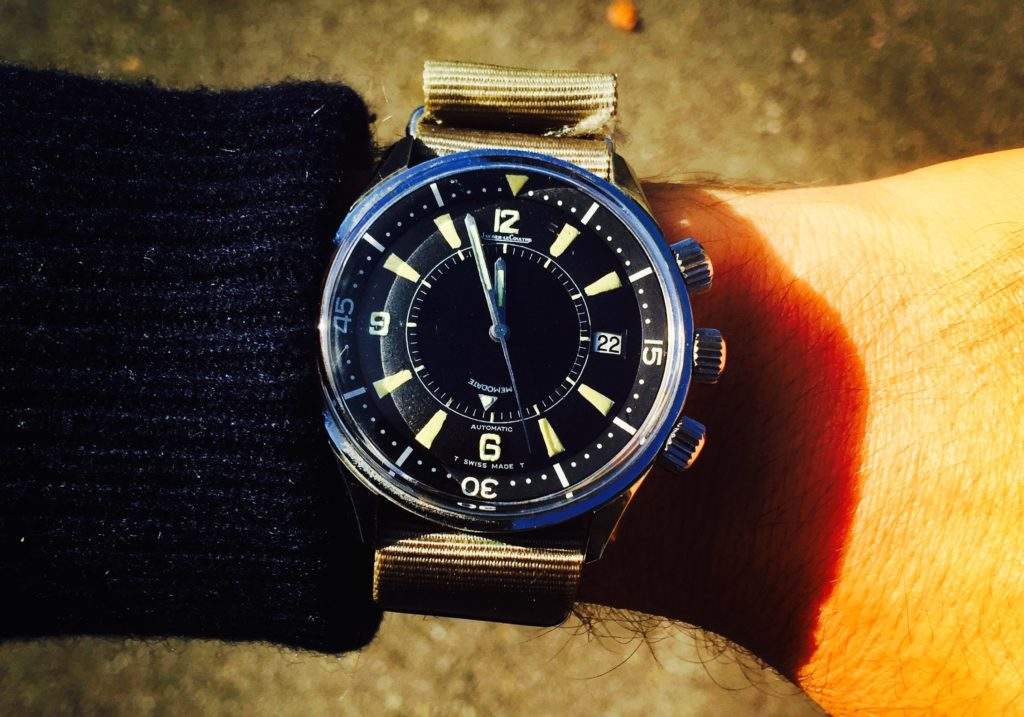
The Polaris is a very rare watch but even more so when you have a full set like Mstanga does. Look at the papers, the box (inner and outer) plus extra dial below.
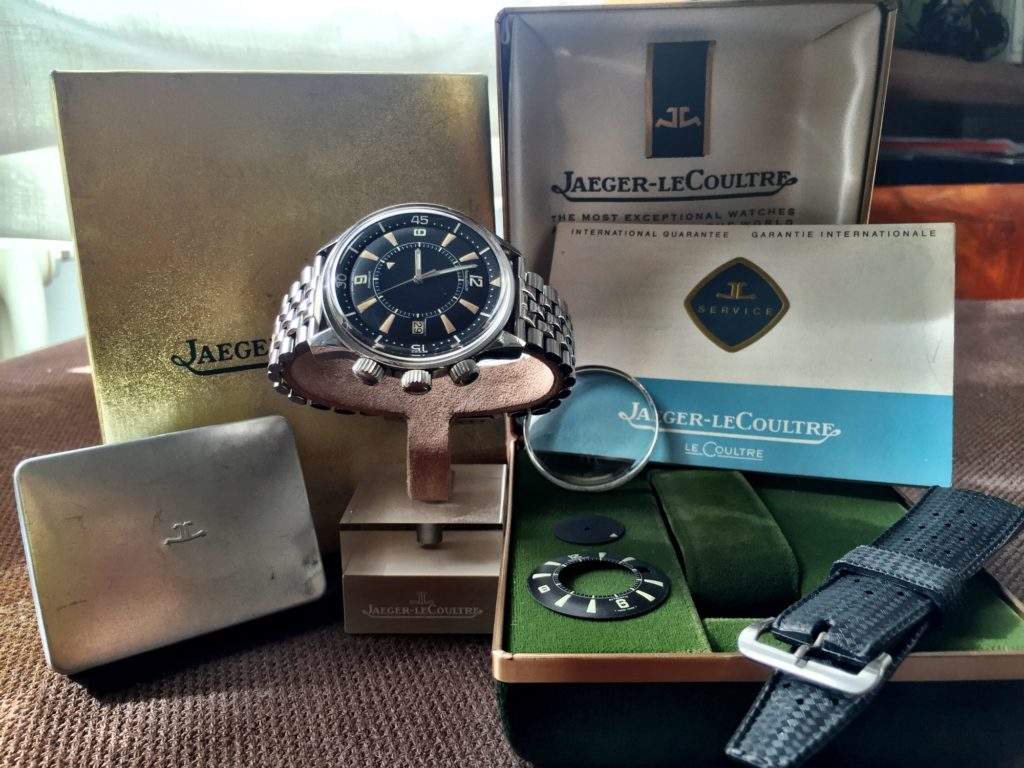
Ever wondered what the instruction manual looks like for the Polaris (and all Memovox models)? Now you know (see below).

Regarding the movement is it easy to check if correct. If it is JLC on the dial then it must also be on the movement as seen in the picture below.

The Polaris was groundbreaking for its time not only for its size. Also for its innovation in being the first diving watch alarm clock that would alert divers under water with sound, rather than only rotating bezel. Let us look at some period advertisement of the Polaris watch as well as instruction manual and brochures:
A French magazine Jaeger displays the Polaris as a watch for the adventurer or man of action. (Credit: Mstanga).

A period correct brochure showing the Polaris far right. (Credit: Mstanga).
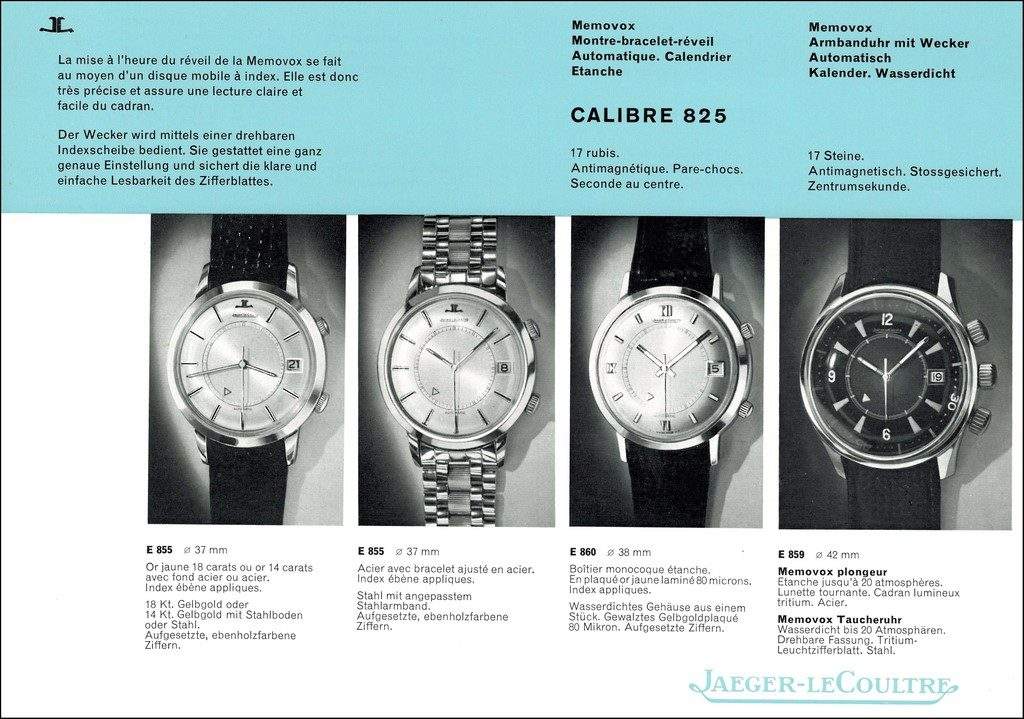
The Polaris in US magazine Ad below. (Credit: Mstanga).

The Polaris, this time the 1965 version in a French magazine advertisement (Credit: Mstanga).

